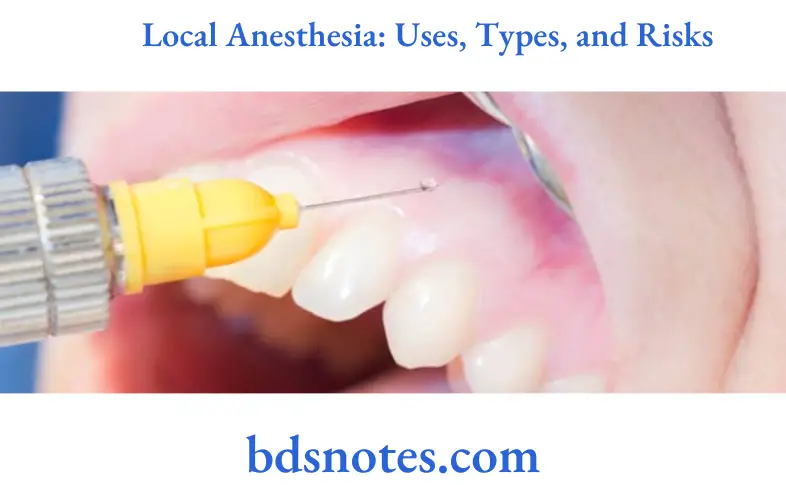Write a short note on Local Anesthesia.
Answer. Local anesthesia is defined as a condition of loss of pain sensation over a portion of the anatomy without loss of consciousness.
Properties of Local Anesthesia
The ideal local anesthetic should possess the following properties:
- Its action must be reversible.
- It must be non-irritating to the tissues and produce no secondary local reaction.
- It should have a low degree of systemic toxicity.
- It should have a rapid onset and be of sufficient duration.
- It should have potency sufficient to give complete anesthesia without the use of a harmful concentration solution.
- It should have sufficient penetrating properties to be effective as a topical anesthetic.
- It should be relatively free from producing allergic reactions.
- It should be stable in solution and undergo trans formation readily within the body.
- It should be either sterile or capable of being sterilized by heat without deterioration.

Techniques Of Local Anesthesia
- Surface anesthesia: Local anesthetic spray is applied by spray, solution, or cream to skin or the mucus membrane.
- Infiltration anesthesia: Local anesthetic is injected into tissue that is to be anesthetized.
Both surface as well as infiltrate anesthesia make up topical anesthesia. - Field block: Subcutaneous injection of local anesthetic agent is given in an area that borders the field to be anesthetized.
- Peripheral nerve block: Local anesthesia is given in the vicinity of the peripheral nerve to anesthetize the nerve’s area, of innervations.
- Plexus anesthesia: Local anesthesia is given in the vicinity of the plexus of the nerve, often inside the tissue compartment which limits the diffusion of the drug away from the site of injection.
- Epidural anesthesia: In this Local anesthetic solution is injected in the epidural space where it acts primarily on spinal nerve roots.
Depending on site of anesthesia and volume injected, the anesthetized area varies from limited areas of the abdomen or chest to large regions of the body. - Spinal anesthesia: It is given at lumbar spine in CSF where it acts on the spinal nerve root and at the part of spinal cord.
Anesthesia occurs from legs to abdomen or chest. - Regional anesthesia: In this method, circulation of blood over a limb is interrupted by a tourniquet, then a large volume of local anesthetic is injected into the peripheral vein.
Now the drug fils the venous system of limb and diffuses in the tissues where peripheral nerves and nerve endings anesthetize.
Effect of anesthesia is limited to the area which gets excluded from blood circulation and resolves as circulation is restored.
Uses Of Local Anesthesia
- In dentistry: Surface or infiltration anesthesia is used during restorative procedures or extractions. Regional nerve blocks are used in oral surgical procedures.
- Ophthalmic surgeries: Surface anesthesia and topical anesthetics are used. In eyes, retrobulbar block can also be given.
- In head and neck surgery: Field block, peripheral nerve block and plexus anesthesia is used.
- During heart and lung surgeries: Epidural anesthesia is combined with the general anesthesia.
- In abdominal surgery: Epidural or spinal anesthesia is combined with the general anesthesia.
- In gynecological and urological procedures: Spinal or epidural anesthesia is given.
- In skin and peripheral vascular surgery: Topical anesthesia,fild block, peripheral nerve block or epidural anesthesia can be given.
Complications or Risks of Local Anesthesia
- Local Anesthesia – Local Complications
- Needle breakage
- Paresthesia
- Facial nerve paralysis
- Trismus
- Hematoma
- Burning on giving injection
- Infection
- Edema
- Soft tissue injury
- Sloughing of tissues
- Postanesthetic intraoral lesion
- Local Anesthesia – Systemic complications:
- Toxicity
- Idiosyncrasy
- Allergy
- Anaphylactic reactions.

Leave a Reply